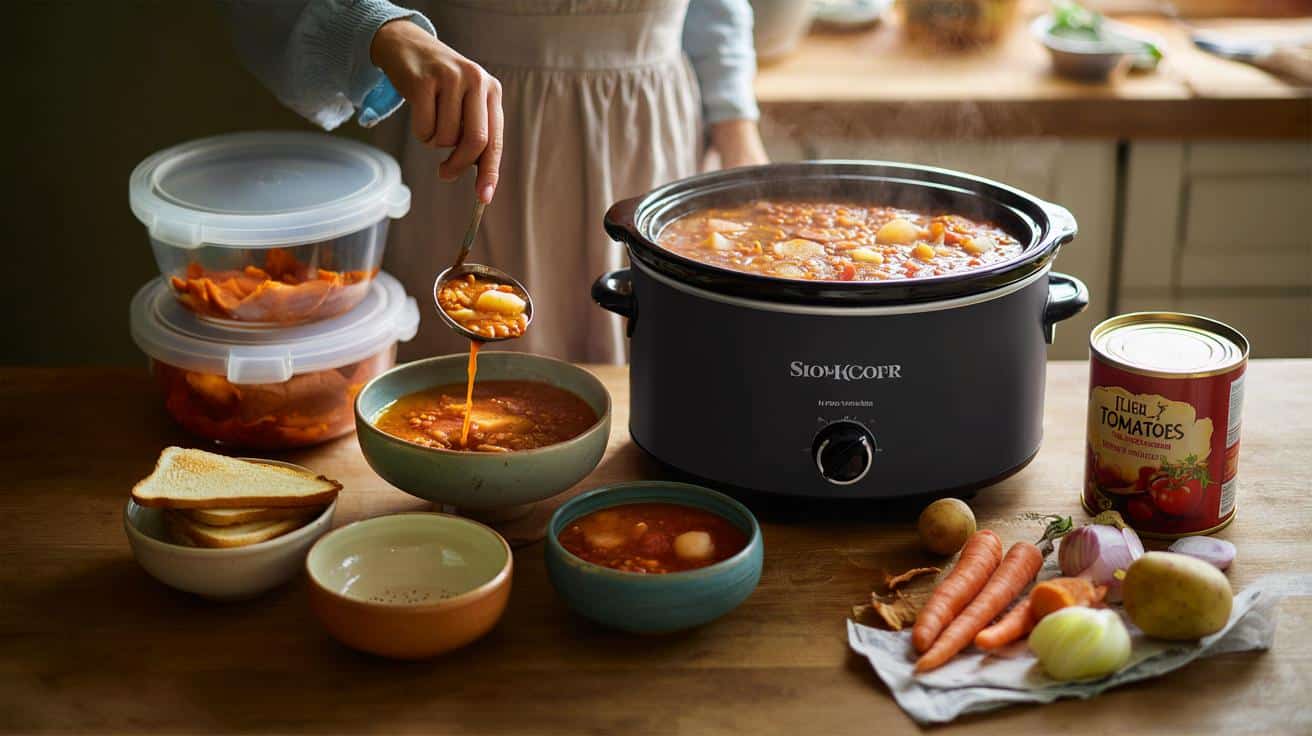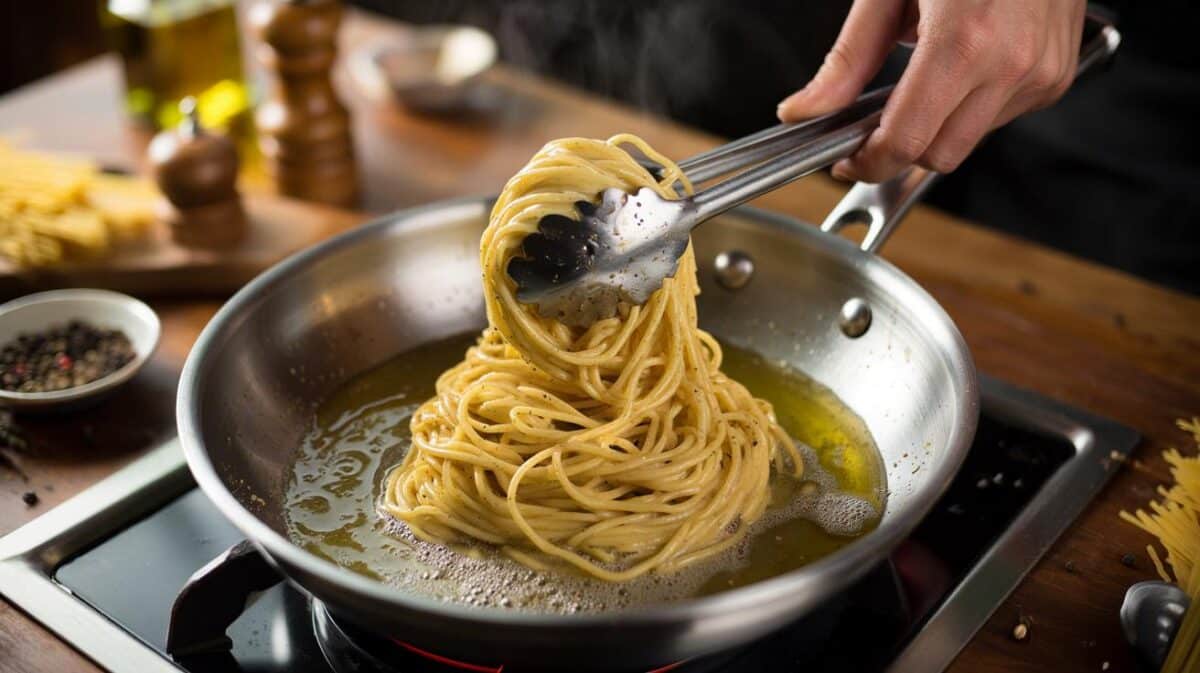Grocery prices keep nibbling at our paycheques, and family dinners have turned into a minor maths problem. Budget cooks are quietly winning with one humble move: a slow cooker pot that costs about £3 and feeds four, twice.
On the worktop, a pile of onions and carrots sits next to a dented tin of tomatoes, the sort of ingredients that don’t look like much until the lid goes on. A mum in a dressing gown taps a spoon on the rim, glances at the clock, and smiles because dinner is already making itself while she gets on with the day. By six, the hallway smells like something you’d pay for in a pub. Neighbours pass the door and pause. The lad asks what’s for tea, not “Is there anything?”. The answer is simple and warm. The trick isn’t fancy.
The £3 pot that keeps giving
You can call it stew or soup or “big tea,” but the heart of it is the same: red lentils, potatoes, carrots, onions, a tin of tomatoes, stock, and time. The slow cooker turns cheap veg sweet and silky, and the lentils swell to give body like cream without the price tag. **This is the £3 pot that keeps giving.** It’s the sort of meal that waits for you, not the other way around, and that’s a power move on a school night.
Amira in Leeds swears by it. She spends £3.04 on the bits she actually uses from her weekly shop and ladles out ten deep bowls by the end, which is dinner and lunch the next day with bread soldiers. She once took a tub to football practice and fed two hungry extras on the sidelines. People talk about energy costs; a slow cooker ticks along gently, using about as much electricity as a couple of lamps, so the pennies stay friendly while the flavour grows up.
Why it works is more kitchen maths than magic. Lentils bring protein and starch, the veg bring sweetness and minerals, and the long simmer turns everything into a soft, spoonable tangle. Salt draws water, so it’s smarter late than early, and onions plus tomato give that savoury backbone restaurants call depth. **Salt late, flavour early.** Add herbs or a pinch of curry powder to nudge it one way or the other, but the base is solid because the chemistry is on your side.
How to cook the £3 slow-cooker stew
Method that fits around real life: Rinse 300g red lentils in cold water. Dice two onions, three carrots, and three medium potatoes. Tip it all into the slow cooker with one tin of chopped tomatoes, two stock cubes dissolved in 1.2 litres hot water, a spoon of tomato purée if you’ve got it, and a teaspoon of mixed herbs or mild curry powder. Lid on. Low for 7–8 hours or high for 4–5, then taste and salt. If you like it thicker, stir in 2 tablespoons of porridge oats for the last 30 minutes. Finish with a splash of vinegar or lemon to wake it up. Portion in bowls, save the rest for day two. Done.
We’ve all had that moment when the fridge looks bleak and the clock looks smug. This pot is an answer to both. Soupy? Take the lid off for the last half-hour, or mash a few potatoes against the side to bring it together. Too thick? Add a mug of boiling water and stir. Let’s be honest: no one does that every day. But you can do this on Mondays and feel like a genius on Tuesdays.
“It’s not poverty food; it’s Tuesday food,” says Sophie, a budget cook from Coventry. “I feed four, send two lunches, and I’m still washing fewer pans.”
Here’s a straight-talking £3 shopping list with per-use costs:
- Red lentils, 300g from a 500g bag (£0.95 per bag) ≈ £0.57
- Chopped tomatoes, 1 tin ≈ £0.28
- Onions, 2 from a 1kg bag ≈ £0.27
- Carrots, 3 from a 1kg bag ≈ £0.24
- Potatoes, 3 from a 2.5kg sack ≈ £0.25
- Stock cubes, 2 from a value pack ≈ £0.10
- Porridge oats, 2 tbsp from a value bag ≈ £0.05
- Oil, herbs, splash of vinegar ≈ £0.15
Leftovers are a feature, not a failure.
Two days, zero faff
The second day is where it gets interesting. Stir in a cup of frozen peas and a spoon of garam masala for a cosy curry bowl, or loosen with water and blend half for a café-style soup with toast. Fold in shredded roast chicken from Sunday if you’ve got it, or top with cheesy mash and bake for a five-minute fake pie. The base is kind, so it plays well with anything in your fridge that needs a home. *This isn’t about perfection; it’s about dinner.* Share tubs with a neighbour, trade a jar for a school run; this is community food without a big speech. The price is low, the mood is high, and the slow cooker does the heavy lifting while life rolls on.
| Point clé | Détail | Intérêt pour le lecteur |
|---|---|---|
| £3 all-in, real portions | Uses per-portion costs from value packs to keep the full pot under £3 | Makes dinner and next-day lunches without stretching the wallet |
| Set-and-forget method | Five minutes of prep, 4–8 hours of gentle cooking, minimal washing-up | Frees time and headspace on busy weekdays |
| Flexible second-day flips | Turn into soup, curry bowl, or pie-topped bake with pantry bits | Prevents waste and keeps meals feeling new |
FAQ :
- Can £3 really feed a family of four for two days?Yes, when you cost what you use from bigger value packs. This recipe yields about 8–10 hearty servings, enough for dinner and a second meal.
- Do I have to use red lentils?No. Pearl barley or yellow split peas work, though they take longer. Red lentils cook fastest and thicken the pot naturally.
- Will kids eat it?Most do when it’s soft, mild, and warm. Keep spices gentle, serve with bread, and call it “tomato potato soup” if that helps.
- What if I don’t own a slow cooker?Use a lidded pot on the hob at a lazy simmer for 60–75 minutes, stirring now and then and adding water as needed.
- How should I store and reheat leftovers?Cool quickly, refrigerate in tubs for up to three days, or freeze for a month. Reheat until piping hot, adding a splash of water to loosen.










Actually made this last night with basic supermarket bits—came to £3.22 in my area but still fed 4 with lunchboxes. The lentils make it proper hearty; oats at the end thickened nicely. I added a splash of malt vinigar and it woke the whole pot up. Definately repeating.
£3 all-in, really? Where are you shopping? Even value tinned toms are 38–40p here, and onions have gone up. Also, how much eletricity does the slow cooker use per hour? Trying to do the full maths before I jump in.